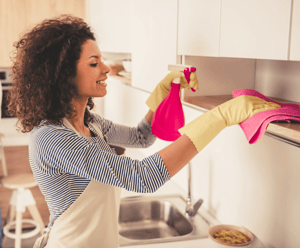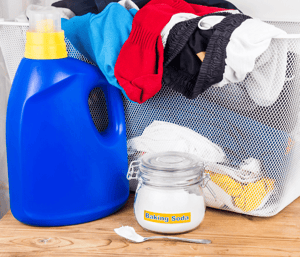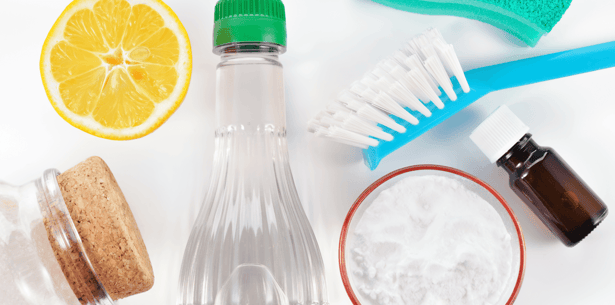Many of us may have grown up in households where strong chemicals and powerful-smelling bleach was used for cleaning. But these days, more and more people are looking for safer and more environmentally friendly ways to keep their homes tidy and fresh.
Cleaning products are home essentials but that doesn't mean they have to be costly or toxic.
Thankfully, there are a number of simple recipes you can easily make at home and great new products in the shops that use non-toxic "green" ingredients to make your house clean and safe.
Basic Ingredients
Not only will the following ingredients help keep your home sparkling clean, they're often a lot cheaper than standard commercial cleaners. Keep in mind that, although these are all non-toxic, you still need to keep them away from kids and pets.
- Baking soda (sodium bicarbonate).
- White vinegar.
- Lemon juice.
- Castile soap (a liquid soap made only with vegetable oils).
- Rubbing alcohol (isopropyl alcohol).
- Borax.
- Olive oil.
 Kitchen
Kitchen
As mentioned, undiluted vinegar is the best way to both clean and disinfect most hard surfaces. You can also add a cup of vinegar into your dishwasher to help remove hard water deposits.
Built-up grease on stove tops can be removed with either lemon juice or a paste made with baking powder and a little warm water. Sprinkle baking powder onto any fresh oil or grease spills, enough to absorb the mess.
For granite and other kinds of stone countertops, mix rubbing alcohol with water in equal parts.
If there are any unidentified sticky spots on your counter or other surfaces, apply some lemon juice to a cotton ball and rub to remove.
For heavily soiled pots and pans, add some (ordinary table) salt and lemon juice. Be sure to rinse thoroughly in order to remove all the salt.
Bathroom
You can both clean and disinfect all the surfaces in your bathroom by using white vinegar (undiluted). Fill a spray bottle with vinegar and apply liberally, allowing to soak for a few minutes before rinsing with hot water. Vinegar also does a great job of removing built-up soap scum.
Vinegar is a natural odour absorber, so cleaning with vinegar also works extremely well as a deodorizer.
For glass and mirrors, use a combination that is half vinegar and half water. Alternatively, mix rubbing alcohol and witch hazel.
For metal and shiny surfaces, soak a cotton ball in rubbing alcohol.
For white porcelain and enamel surfaces, add a small amount of warm water to baking soda in order to create a paste.
For plastic or vinyl surfaces (like shower curtains), mix one-third vinegar with two-thirds water. Spray anywhere that mould or mildew might grow and allow to sit for 15 minutes before rinsing clean.
For your toilet, first, flush the water and then sprinkle a generous amount of baking powder into the bowl. Allow it to sit for 10 minutes before scrubbing and flushing again.
For drains, pour one litre or more of boiling water directly into the drain to loosen clogs. For more stubborn clogs, pour half a cup of baking powder into the drain. Then add half a cup of vinegar. Allow it to rest for several hours before rinsing out the drain with hot or boiling water.
 Laundry
Laundry
Adding around 1/4 cup of white vinegar to your wash cycle will deodorize your clothes. This is especially effective at getting rid of sweaty or musty odours.
For white clothes, try adding 1/4 cup of vinegar and 1/2 cup of baking soda to your wash load.
To pre-treat stains, make a paste of baking powder and a little warm water, applying it to the stained area.
Borax is a natural water softener. It also works to help make your clothes look cleaner and brighter.
Other Areas of the House
Olive oil is a great way to clean wood surfaces. Just be sure to test out a small area first. Apply the olive oil to a clean, lint-free cloth. Alternatively, mix two parts olive oil with one part lemon juice.
To clean floors, mix 1/8 cup of liquid Castile soap and 1/8 cup of vinegar to one gallon of hot water.
For vinyl and similar surfaces, apply the undiluted lemon juice to a clean cloth. This will also remove stains.
To remove odours of any kind, including paint, mustiness, sweat, burned food, or tobacco fumes, fill a few shallow dishes with undiluted vinegar. The vinegar will work to trap the odours. For continued effect, change the vinegar once daily.
To clean copper or brass, make a paste with one-third (ordinary) flour, one-third salt, and one-third vinegar. Rub the paste onto the brass or copper surface and allow to stand for a full hour.
For lightly tarnished copper, apply vinegar and then sprinkle the affected area with salt. Be sure to thoroughly wipe off all the salt or the copper will turn green.
To help keep the chimney and interior of a wood-burning chimney clean, throw a handful of salt into the fire during use.
To reduce air pollution, including dust and large particulates, use living plants. Put at least one potted plant in each room. The plant will help clean the air while its leaves will attract and remove a lot of the airborne particulates.
For stains on white painted surfaces like interior walls, mix one part borax with six parts water.
Give It a Try!
If you've never tried cleaning with green products before, you might be surprised at just how effective they are at removing stains, deodorizing, and leaving everything smelling and looking great.
The right combination of a few basic ingredients will help you protect the environment as well as minimize you and your family's exposure to dangerous and toxic chemicals. Best of all, you'll save a lot of money when you use green cleaners to keep your home neat and tidy!
See if you can complete all the tasks on our ultimate home cleaning list using only green products, and let us know what you think!




